This hike explores the northern end of the New Jersey Section of the Palisades Interstate Park. It is, perhaps, the most rewarding loop hike in the park, as it incorporates a number of scenic features and, for nearly the entire distance, you are far away from the noise of the Parkway. But it is also the most difficult hike in the park, as it involves not only steep climbs and descents on...
Hike Description:
This hike explores the northern end of the New Jersey Section of the Palisades Interstate Park. It is, perhaps, the most rewarding loop hike in the park, as it incorporates a number of scenic features and, for nearly the entire distance, you are far away from the noise of the Parkway. But it is also the most difficult hike in the park, as it involves not only steep climbs and descents on uneven rock steps, but also over half a mile of walking near the shore of the river on jumbled rocks. Make sure you allow enough time to complete the hike before dark, and wear sturdy footwear with rubber soles. Don't attempt the hike if is wet or icy outside.
The hike begins at the northwest corner of the parking area at the State Line Lookout, at a sign for the "Long Path." Follow the wide path into the woods. You'll soon reach a junction where the Long Path turns left and Trail A comes in from the left and proceeds ahead. Continue ahead on the wide path. Just beyond, you'll come to another junction. Here, Trail C begins on the right, but you should continue ahead on Trail A. In 750 feet, you'll reach another junction, marked by an old rock monument on the left. Trail B proceeds ahead, but you should turn left to continue on Trail A.
After continuing straight ahead at the next intersection, you'll come to the lookout access road. Cross the road and continue ahead on the aqua-blazed Long Path, which heads south, parallel to the cliffs. There is a broad viewpoint over the river just to the left of the trail (use caution here, as there is a steep drop-off). Just beyond, the trail starts a steep descent on rock steps, built by the park in the early years of the twentieth century. Use extreme caution when descending these steps, as they are somewhat uneven. The steps can be particularly hazardous when wet or covered with leaves.
After crossing a small stream on a wooden footbridge, you'll reach a trail junction. Here, the Long Path turns right, but you should bear left, now following the blue/white-blazed Forest View Trail. A sign indicates that it is 0.3 mile from this point to the Shore Trail, but the distance will probably seem much longer. The steep descent continues, first on more rock steps (and some wooden steps), then on switchbacks, some of which are well graded, but others are rocky and uneven.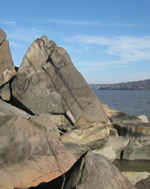
You'll finally reach the bottom of the descent, marked by a large boulder. Here you should turn left and head north on the white-blazed Shore Trail. Soon, you'll emerge onto an open area covered with vines. Take a moment to contemplate this magnificent "sea of green."
After traversing a wooded area, you'll reach a field of jumbled boulders. This is the beginning of the Giant Stairs, the most challenging section of the hike. After taking in the panoramic view to the north along the river and over the striking Palisades cliffs, bear left and follow the white blazes as they begin to climb on rock steps and jumbled rocks.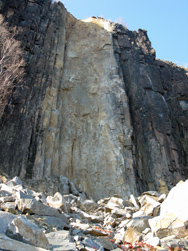
After climbing for about 100 vertical feet, the trail bears right and continues to head north, parallel to the river below. For the next half mile, the trail follows a rocky path above the river. The trail is littered with huge boulders that have fallen down from the cliffs above, and you’ll have to use care climbing over and around these boulders, and deciding where to take each step. Most of the trail in this area is wooded, but you'll come out on several open talus stopes. One of these slopes is the site of the massive rockslide that took place at 7:28 p.m. on Saturday, May 12, 2012, in which a large section of the cliff face broke off and tumbled down to the river. The upper portion of this rockslide has grown in with vegetation, and the lighter-faced rock column that indicates the location of the slide may not be visible from the trail.
Towards the end of the section with the jumbled boulders, the trail comes out onto two open talus slopes that afford panoramic views over the river. These are good spots to rest from this difficult section of the hike and enjoy the views.
The trail now becomes much smoother. About half a mile from the northern end of the section with the jumbled boulders, you'll go down to the river level at the New Jersey-New York boundary (which is not marked on the ground). Here, you'll again have to traverse a section with jumbled boulders, but this one is much easier to negotiate. There are panoramic north-facing views over the Hudson River, with the Tappan Zee Bridge visible in the distance. At the northern end of this section, a sign (facing the other direction) marks the northern end of the Giant Stairs.
After another half mile of walking on a relatively smooth footpath along the river, you'll go through a gate in a rusted chain-link fence. A short distance beyond, you'll reach the Peanut Leap Cascade. Adjacent to this waterfall, which is truly spectacular after heavy rains, are the ruins of the Italian Garden, built about 1900 by the sculptress Mary Lawrence-Tonetti, whose family owned an estate at nearby Sneden's Landing.
After spending some time at this interesting and beautiful spot, follow the white-blazed Shore Trail as it turns left, away from the river, and climbs -- first on the concrete stairs of the Italian Gardens ruins, then on wooden steps and switchbacks. It parallels the stream leading to the waterfall and soon ends at a junction with the aqua-blazed Long Path. Turn left onto the Long Path, which you will follow all the way back to the State Line Lookout.
The Long Path crosses the stream on two wooden bridges. A short distance ahead, it turns sharply right and begins a steep climb on stone steps. At the top of the climb is High Gutter 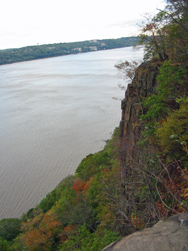 Point, a panoramic viewpoint up and down the river. To the north, you can see the Tappan Zee Bridge and Hook Mountain, the northernmost point on the Palisades along the Hudson. You'll want to take a break here to rest from the steep climb and enjoy the view, but use caution, as the drop-off is very steep.
Point, a panoramic viewpoint up and down the river. To the north, you can see the Tappan Zee Bridge and Hook Mountain, the northernmost point on the Palisades along the Hudson. You'll want to take a break here to rest from the steep climb and enjoy the view, but use caution, as the drop-off is very steep.
The trail continues ahead, passing several more viewpoints, then bears left, goes through a gate in a chain-link fence that marks the boundary between New York and New Jersey, and briefly parallels the fence. When the trail bears left, away from the fence, continue ahead for about 50 feet to see a stone monument, placed in 1882 to mark the state line.
Return to the aqua-blazed Long Path, which turns left just beyond the monument, then takes the left fork at the next intersection (along with Ski Trail E). It follows an old woods road for about half a mile to reach the Old Route 9W (a wide concrete road), then turns left along the road and follows it for a short distance back to the State Line Lookout, where the hike began.
Publication: Submitted by Daniel Chazin on 10/21/2005 updated/verified on 05/30/2023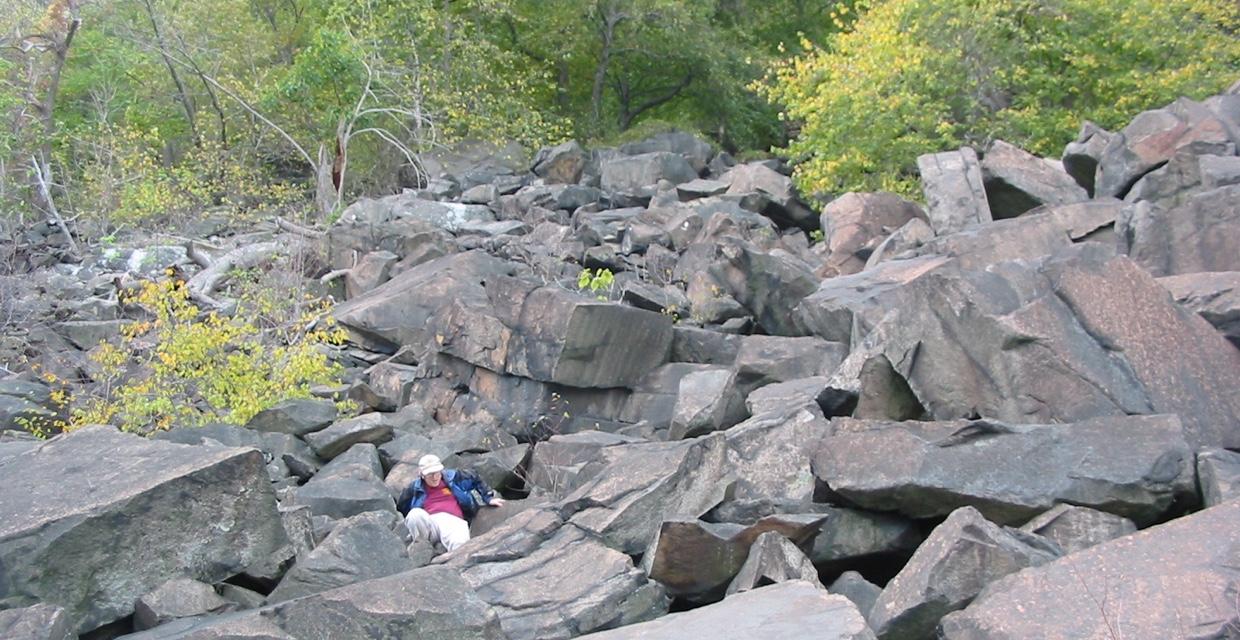
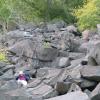
Hike Checklist:
Whether you are going for a day hike or backpacking overnight, it is good practice to carry what we call The Hiking Essentials. These essentials will help you enjoy your outing more and will provide basic safety gear if needed. There may also be more essentials, depending on the season and your needs.
The Essentials
Hiking Shoes or Boots
Water - Two quarts per person is recommended in every season. Keep in mind that fluid loss is heightened in winter as well as summer. Don't put yourself in the position of having to end your hike early because you have run out of water.
Map - Know where you are and where you are going. Many of our hiking areas feature interconnecting network of trails. Use a waterproof/tear-resistant Tyvek Trail Conference map if available or enclose your map in a Ziplock plastic bag. If you have a mobile device, download Avenza’s free PDF Maps app and grab some GPS-enhanced Trail Conference maps (a backup Tyvek or paper version of the map is good to have just in case your batteries die or you don't have service). Check out some map-reading basics here.
Food - Snacks/lunch will keep you going as you burn energy walking or climbing. Nuts, seeds, and chocolate are favorites on the trail.
Sunscreen and insect repellent
Rain Gear and Extra Clothing - Rain happens. So does cold. Be prepared for changing weather. Avoid cotton--it traps water against your skin and is slow to dry. If you are wearing wet cotton and must return to your starting point, you risk getting chills that may lead to a dangerous hypothermia. Choose synthetic shirts, sweaters and/or vests and dress in layers for easy on and off.
Compass - A simple compass is all you need to orient you and your map to magnetic north.
Light - A flashlight or small, lightweight headlamp will be welcome gear if you find yourself still on the trail when darkness falls. Check the batteries before you start out and have extras in your pack.
First Aid Kit - Keep it simple, compact, and weatherproof. Know how to use the basic components.
Firestarter and Matches - In an emergency, you may need to keep yourself or someone else warm until help arrives. A firestarter (this could be as simple as leftover birthday candles that are kept inside a waterproof container) and matches (again, make sure to keep them in a waterproof container) could save a life.
Knife or Multi-tool - You may need to cut a piece of moleskin to put over a blister, repair a piece of broken equipment, or solve some other unexpected problem.
Emergency Numbers - Know the emergency numbers for the area you're going to and realize that in many locations--especially mountainous ones, your phone will not get reception.
Common Sense - Pay attention to your environment, your energy, and the condition of your companions. Has the weather turned rainy? Is daylight fading? Did you drink all your water? Did your companion fail to bring rain gear? Are you getting tired? Keep in mind that until you turn around you are (typically) only half-way to completing your hike--you must still get back to where you started from! (Exceptions are loop hikes.)
Check the weather forecast before you head out. Know the rules and regulations of the area.
The Leave No Trace Seven Principles
Plan Ahead and Prepare
- Know the regulations and special concerns for the area you'll visit.
- Prepare for extreme weather, hazards, and emergencies.
- Schedule your trip to avoid times of high use.
- Visit in small groups when possible. Consider splitting larger groups into smaller groups.
- Repackage food to minimize waste.
- Use a map and compass to eliminate the use of marking paint, rock cairns or flagging.
Travel and Camp on Durable Surfaces
- Durable surfaces include established trails and campsites, rock, gravel, dry grasses or snow.
- Protect riparian areas by camping at least 200 feet from lakes and streams.
- Good campsites are found, not made. Altering a site is not necessary.
- In popular areas:
- Concentrate use on existing trails and campsites.
- Walk single file in the middle of the trail, even when wet or muddy.
- Keep campsites small. Focus activity in areas where vegetation is absent.
- In pristine areas:
- Disperse use to prevent the creation of campsites and trails.
- Avoid places where impacts are just beginning.
- Pack it in, pack it out. Inspect your campsite and rest areas for trash or spilled foods. Pack out all trash, leftover food and litter.
- Deposit solid human waste in catholes dug 6 to 8 inches deep, at least 200 feet from water, camp and trails. Cover and disguise the cathole when finished.
- Pack out toilet paper and hygiene products.
- To wash yourself or your dishes, carry water 200 feet away from streams or lakes and use small amounts of biodegradable soap. Scatter strained dishwater.
- Preserve the past: examine, but do not touch cultural or historic structures and artifacts.
- Leave rocks, plants and other natural objects as you find them.
- Avoid introducing or transporting non-native species.
- Do not build structures, furniture, or dig trenches.
- Campfires can cause lasting impacts to the backcountry. Use a lightweight stove for cooking and enjoy a candle lantern for light.
- Where fires are permitted, use established fire rings, fire pans, or mound fires.
- Keep fires small. Only use sticks from the ground that can be broken by hand.
- Burn all wood and coals to ash, put out campfires completely, then scatter cool ashes.
- Observe wildlife from a distance. Do not follow or approach them.
- Never feed animals. Feeding wildlife damages their health, alters natural behaviors, and exposes them to predators and other dangers.
- Protect wildlife and your food by storing rations and trash securely.
- Control pets at all times, or leave them at home.
- Avoid wildlife during sensitive times: mating, nesting, raising young, or winter.
Be Considerate of Other Visitors
- Respect other visitors and protect the quality of their experience.
- Be courteous. Yield to other users on the trail.
- Step to the downhill side of the trail when encountering pack stock.
- Take breaks and camp away from trails and other visitors.
- Let nature's sounds prevail. Avoid loud voices and noises.
The Trail Conference is a 2015 Leave No Trace partner.
(c) Leave No Trace Center for Outdoor Ethics: www.LNT.org.


